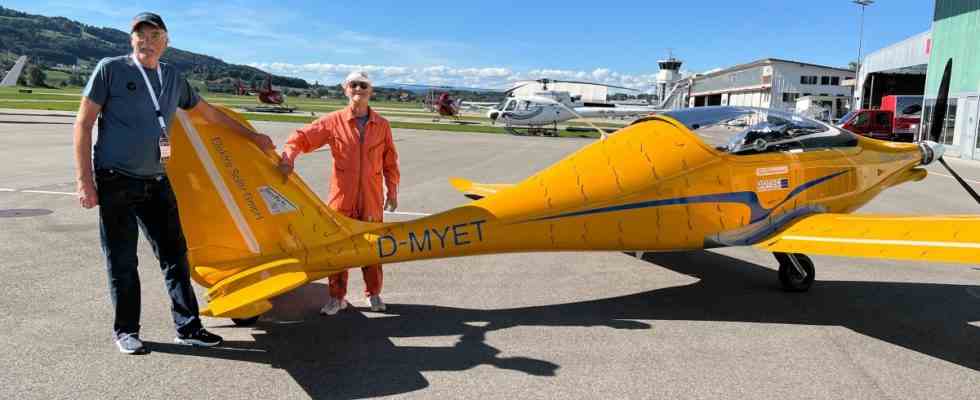The reputation of aviation has suffered greatly in the course of the climate debate, there is constant talk of shame about flying, and the short domestic flights in particular have come under heavy criticism because of the emissions they generate. Almost unnoticed by the public, a small company in Landsberg am Lech has now developed an aircraft that could at least revolutionize flight operations over short distances and flight school operations.
“I’m really excited,” said the experienced pilot Uwe Northmann recently at a ceremony in the production hall of Elektra Solar in Landsberg am Lech. Nortmann subjected the aircraft to an extensive endurance test and then got enthusiastic: “It’s a completely different type of flying,” he said and revealed that the flight performance of such a machine particularly benefits if you take advantage of the thermals.
In terms of safety, too, there is nothing to complain about at first glance. Two motors work independently of each other, if one fails, you can continue flying with the other at any time. In extreme danger, a parachute could even be deployed, allowing the plane to fall to earth at least so slowly that no one would die.
The electric aircraft developed by twelve engineers over a period of twelve years also stands out due to its low noise level. The measuring devices show 48 decibels, “that’s at most as loud as a light rain,” said the aviation engineer Calin Gologan, one of the two shareholders of the company Elektra Solar, which developed the plane. When the machine flew 150 meters above the factory building, nothing could be heard from below, it was said at the celebration.
The mechanics and robotics scientist Gerd Hirzinger, who was head of the Institute for Robotics and Mechatronics at the German Aerospace Center in Oberpfaffenhofen from 1992 to 2012, is also involved in the company. His expertise was also extensively incorporated into the project.
Hovering like an eagle: the measuring devices on the solar plane show only 48 decibels, which is at most as loud as light rain.
(Photo: Elektra Solar GmbH)
With the two-seater model Elektra Trainer, the company has already received the second individual approval for a fully electrically powered aircraft. As early as 2011, the Elektra One, a single-seat ultralight aircraft with solar-assisted electric propulsion, took to the air for the first time. Four years later, this was the first purely electric crossing of the Alps.
The Elektra Trainer model is the first two-seat, all-electric training and towing aircraft. It has demonstrated its reliability and robustness in a good hundred test flights, the designers said at the celebration, visibly proud.
The aircraft has a wingspan of 14.5 meters and can accommodate two occupants seated side by side. The drive generates a continuous output of 40 kilowatts and a maximum output of 50 kilowatts. The cruising speed is 120 km/h, the top speed is 180 km/h.
Pilot and engineer Tobias Riedler in the cockpit of the battery-powered ultralight aircraft.
(Photo: Hans scratches)
As the guests learned, the Elektra trainer achieves a flight time of 2.5 hours, plus the legally prescribed minimum reserve of 30 minutes. Pilot Northman said he had flown the machine in strong winds before without any problems.
With its glider landing gear, the machine appears light and aerodynamically sleek. To make it attractive to flight schools that have long been waiting for a whisper-quiet electric aircraft, a close-meshed electronic monitoring system was developed for the Elektra Trainer.
Anyone who owns an aircraft today has to store it in a hangar, which is not cheap. Here, too, the Elektra trainer opens up a more favorable perspective, because it can be disassembled and reassembled in half an hour. You no longer need a parking space in the hangar, because you can stow the plane in a specially designed solar trailer, in which it is also recharged.
All that remains is the price, and it’s steep. The plane is said to cost 250,000 euros, although, as Gologan objects, you have to take into account that you will save a large part of the operating costs that a combustion engine would cause in the future, from operating costs to maintenance to fuel . Everyone assumes that prices will fall in the future, as they do for e-cars.
If the project is to be a success, says Gologan, “we don’t have to convince thousands, but millions of people.” A ten-seater electric aircraft is already being planned, which should cover distances of up to 500 kilometers. That would save a lot of time for business travelers, if only because these planes can also take off and land on grassy areas.

